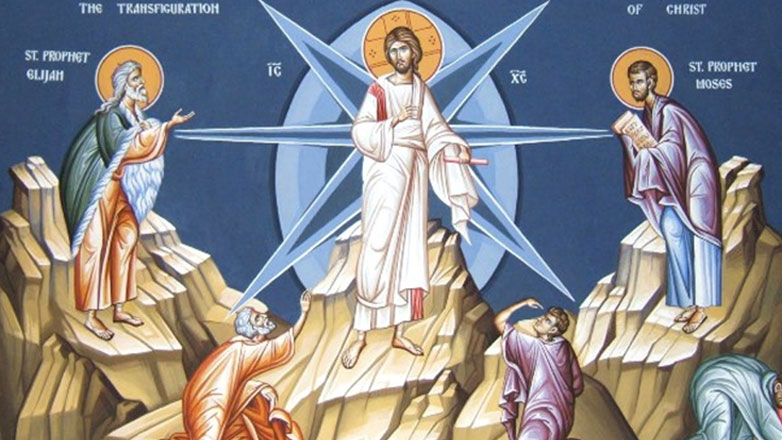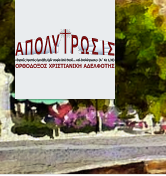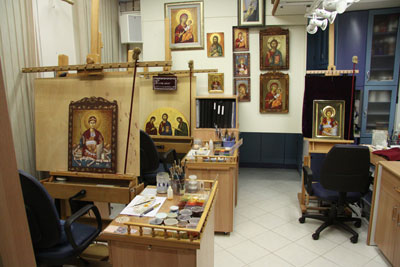Translated excerpts from the book:
Στεργίου Ν. Σάκκου [Read CV], «Λάμψον καὶ ἡμῖν...», ἐκδ. «ΧΡΙΣΤΙΑΝΙΚΗ ΕΛΠΙΣ» ΟΡΘΟΔΟΞΗ ΑΔΕΛΦΟΤΗΤΑ, Θεσ/νίκη 2023.
The Event of the Transfiguration in the Gospels
 Undoubtedly, the God-man Jesus Christ, during His earthly ministry, revealed His divinity in many ways: through His holy life, His words full of divine grace, the supernatural signs He performed upon inanimate creation (the feeding of the five thousand, the calming of the storm on the Sea of Galilee), as well as upon human beings themselves (healings, resurrections of the dead). However, during the Transfiguration, His revelation took place in a wholly unique manner. There, to the extent permitted by human nature, His divine glory was revealed. This event is narrated by the evangelists Matthew (17:1–8), Mark (9:2–8), and Luke (9:28–36). The evangelist John refers to it briefly, without narrating it (1:14), because he wrote his Gospel later, when the Transfiguration was already known from the other three Gospels that were circulating.
Undoubtedly, the God-man Jesus Christ, during His earthly ministry, revealed His divinity in many ways: through His holy life, His words full of divine grace, the supernatural signs He performed upon inanimate creation (the feeding of the five thousand, the calming of the storm on the Sea of Galilee), as well as upon human beings themselves (healings, resurrections of the dead). However, during the Transfiguration, His revelation took place in a wholly unique manner. There, to the extent permitted by human nature, His divine glory was revealed. This event is narrated by the evangelists Matthew (17:1–8), Mark (9:2–8), and Luke (9:28–36). The evangelist John refers to it briefly, without narrating it (1:14), because he wrote his Gospel later, when the Transfiguration was already known from the other three Gospels that were circulating.
The Transfiguration took place “on a high mountain” (Mt 17:1; Mk 9:2). There, Jesus was with only three of His disciples, away from the crowds, “by themselves” (Mt 17:1; Mk 9:2). The most paradoxical and wondrous things were performed by the Lord secretly and quietly, so that He might not be regarded by the crowds as “a man in appearance only,” as Saint Theophylact observes. Moreover, the Lord did not intend to display His glory before the multitude. His purpose was to grant His own disciples such an experience that they might not be scandalized or irreparably shaken at the time of the Passion, which He had just foretold to them. Through the Transfiguration, He revealed to them His divinity, in order to provide them with unshakable testimony — a firm assurance that His Passion was voluntary, in accordance with the eternal plan of the Triune God for the redemption of humankind. This is also proclaimed in the Kontakion of the feast:
Kontakion — Tone 7
On the mountain You were transfigured, O Christ God,
and Your disciples beheld Your glory as far as they could bear;
so that when they would see You crucified,
they would understand that Your suffering was voluntary,
and would proclaim to the world
that You are truly the radiance of the Father.
The Lord chose Peter, John, and James to go up with Him onto the mountain. Three witnesses were sufficient to confirm an event, according to Deuteronomy: “On the evidence of two witnesses or of three witnesses, a matter shall be confirmed” (see Deut 19:15). So, three disciples were enough to bear witness to the Transfiguration. These same three were also with Him at the raising of Jairus’ daughter (Mk 5:37) and during the agony in Gethsemane (Mt 26:37). Saint John Chrysostom explains: “These were superior to the others.” These three stood out among the Twelve and seem to have formed the core of the group. Peter, as we observe in the Book of Acts, later emerged as the foremost among the apostles. John was the only one among the disciples who followed Jesus as far as the Cross of Golgotha (see Jn 19:26). James was the first among the apostles to suffer martyrdom (see Acts 12:2). These, then, were the ones whom the Lord chose to take with Him, so that they might later be able, at the appropriate time, to convey to the others what they themselves had experienced.
The Transfiguration took place “as He was praying” (Lk 9:29). The Lord had gone up onto the mountain with His disciples in order to pray. He frequently withdrew to pray in deserted places (see Mk 1:35; Lk 5:16) and in the stillness of the mountains (see Mt 14:23; Lk 6:12). The God-man was Himself a constant and unceasing prayer. Yet He also made it His practice to pray as a man, so as to inspire His disciples by His example. It was not, therefore, the first time that the disciples saw their Teacher praying (see Lk 11:1). Only on that particular occasion, however, did the Lord allow the radiance of His divinity to become visible during His prayer. If He had allowed this to happen more often, there would have been the danger that His human nature might be questioned, and that He might be considered as only appearing to be human.
In order to grasp, at least in some way, what took place during the Transfiguration, the following example may be helpful — though undoubtedly very imperfect, as it expresses only human reality:
Four soldiers, wearing their cloaks, ascend a mountain on a mission. Along the way, as they converse in a friendly manner, they call one another “comrade.” Upon reaching the summit of the mountain, they sit down to rest. At a certain moment, one of the “comrades” unbuttons part of his cloak, and the others then notice the insignia of a general beneath it. How great their astonishment and admiration! They realize that the one who had humbly walked among them as a simple soldier was, in fact, a general.
So also, we could say, during the Transfiguration, Christ “unbuttoned” His human nature, as it were; He opened the human garment that covered His divinity and allowed a portion of His divine glory to be revealed. It was not possible, of course, for Him to show it in its fullness, for the human eyes of His disciples would not have been able to bear beholding it in all its majesty. Regarding the Lord’s garments, the evangelist Matthew says that they became white as light, while Mark describes them as being like snow, with such a dazzling whiteness that no human effort could achieve it. According to the interpretation of the Fathers, the body of the Lord was entirely radiating the glory of divinity. That is why, as Saint Gregory Palamas clarifies, “His garments, which touched His body, became radiant. And through them, He revealed the garments of glory that those who draw near to God will wear in the age to come.” This light emitted by the Lord’s body and garments was not the ordinary light that makes colors appear brighter, but a light of a different kind — a light that transformed even the garments themselves into light. It was the uncreated light of divinity, which shone forth for the first time on the Mount of the Transfiguration.
Alongside Jesus there appears an exceptionally honored company: Moses, the unparalleled leader and prophet (see Deut 34:10), through whom God delivered His people from bondage in Egypt, and Elijah, the zealous prophet (see 1 Kgs 19:10, 14), who was taken up into heaven without tasting death (see 2 Kgs 2:11).
The two men from the Old Testament appear “in glory” (Lk 9:31), bearing the glory that crowns the saints in heaven (see 1 Pet 5:4). Moreover, according to Saint John Chrysostom, the two men from the Old Testament appeared in order to encourage the disciples by hearing their conversation with the Lord concerning His “departure” (see Lk 9:31). The prophets of the Old Testament had prophesied both about Christ’s entrance into the world and about His departure. His entrance refers to the birth of Jesus, and His departure refers to His death, resurrection, ascension, and His glory in heaven. Before the Transfiguration, the Lord had spoken to His disciples about His departure, and they were filled with fear. Now, the prophets Elijah and Moses appear, conversing with the Lord about the same matter — reminding the disciples of the related prophecies, encouraging them, and strengthening their hearts.The departure of Jesus was arranged by His own will. It was destined to take place in Jerusalem (Lk 9:31), which is the city that “kills the prophets and stones those who are sent to it” (Mt 23:37).
The Transfiguration was not a dream or a vision in the sense of a mere apparition, because three disciples saw it simultaneously. It was a vision (the word is derived from the verb “to see”), a viewing of an actual reality — not something imaginary — a “vision” in the sense in which the term is used by the prophets (cf. Is 1:1). The three disciples, having entered into the frequency of the Spirit, ceased to see and hear with their natural senses. They acquired perception of the supernatural reality with their minds fully alert and through the illumination of the Holy Spirit, by uncreated light. In this way they beheld the glory of the Lord and heard His conversation with the two men from the Old Testament.
While Peter was asking to set up tents, a tent not made by hands appeared: a cloud, as a sign of God’s presence (see Ps 96:2; 103:3). Many times, the presence of God was made perceptible to the Jews through a cloud: in the wilderness after their exodus from Egypt (see Ex 13:21), on Mount Sinai (see Ex 19:16), in the Tabernacle of Testimony (see Ex 40:28), and at the dedication of Solomon’s Temple (see 1 Kings 8:10). A cloud was also the chariot with which the Lord ascended into heaven (see Acts 1:9), and in clouds the faithful will be caught up at the Second Coming to meet Him (see 1 Thess 4:17). The cloud overshadowed the Lord, the two prophets, as well as the three disciples (see Lk 9:34). From within the cloud, a voice was heard. In the event of the Transfiguration, as at the event of the Baptism, all three persons of the Holy Trinity are revealed: the Son is revealed as the God-man in His transfiguration; the Holy Spirit makes His presence known through the luminous cloud; and the Father through the voice that is heard.
The voice of the Father, saying, “This is My beloved Son, with whom I am well pleased” (Mt 17:5; cf. Mk 9:7; Lk 9:35), reveals that the Son is of one essence with the Father. In ancient Greek, the adjective “beloved,” when referring to a son, often means “only-begotten.” The Only-Begotten Son of God, by necessity, is of one essence with God the Father. Just as every human son shares the nature of his human father, so also the Son of God possesses the divine nature, sharing the same essence as God the Father. He “bears the very stamp of his nature” (Heb 1:3). Moreover, the divine voice from within the cloud exhorts: “Listen to Him” (Mt 17:5; Mk 9:7; Lk 9:35). It urges the three disciples of Jesus — and all who will believe in Him — to obey Christ, to submit with trust to His will, even when He calls them to self-denial and sacrifice.
Only with the encouragement of their Teacher did the disciples, who had fallen to the ground in fear (see Mt 17:7), rise again. And as they were coming down from the mountain, the Lord gave them a strict command not to tell anyone what they had seen until after His resurrection (see Mt 17:9; Mk 9:9).









